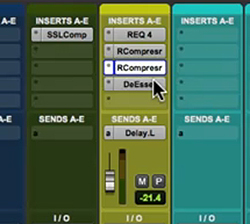Of all the questions I get asked, the one I hear most often is should I record with effects?
In other words, Is it wrong to use plug-ins while I’m recording, or should they only be used for mixing?
My initial answer to this is probably a phrase you should know by heart.
There are no rules.
Before you smack yourself in the forehead and close this window because you’ve probably heard that way too much, I promise I’ll share some practical advice, too.
The thing is…people really do want a set of rules, a step-by-step guide to getting great recordings every single time.
Unfortunately, those simply doesn’t exist. Sometimes breaking the “rules” is the exact thing you should do.
What You Should Know
The first thing you should know when you place a plug-in on a track inside your DAW, you should know that this only affects what you hear. It doesn’t actually change the recorded audio file.
In other words, if you place a bunch of plug-ins on the track while recording, those effects aren’t going to be recorded. The audio gets recorded without any effects, then that recorded signal passes through the plug-ins on the track.
This is important to know, because no matter how badly you mangle the sound with plug-ins during a tracking session, you can always revert back to the original audio signal after-the-fact.
The Good
Putting plug-ins on the tracks while recording can be beneficial. If you’re tracking drums, for example, it might be nice to have your EQ and compression set up already.
An engineer friend of mine here in Nashville actually does this. He’ll set up EQ, compression, etc. on his drum tracks, so they’ll sound more “mixed” when the producer comes by to hear how things are going.
This lets you be aggressive and creative without irreversibly harming the audio.
Also, I almost always use reverb when recording (especially vocals). It’s very unnerving as a singer to sing without any sort of reverb. I’ll usually use something fairy over-the-top for tracking, then dial it back during mixing.
The Bad
I rarely use EQ or compressor plug-ins while tracking. Why? Because it prevents me from hearing what the actual recorded audio sounds like.
If I’m using an EQ to reduce low-mid boomy-ness on a track, would it be better to go back and adjust the mic placement before recording? Probably.
There are no right or wrong answers, but hopefully you can see how plug-ins can be very useful during recording…or you may decide it’s not for you.
What is your prefered process? Let me know in the comments below!
Joe Gilder is a Nashville based engineer, musician, and producer who also provides training and advice at the Home Studio Corner.
















